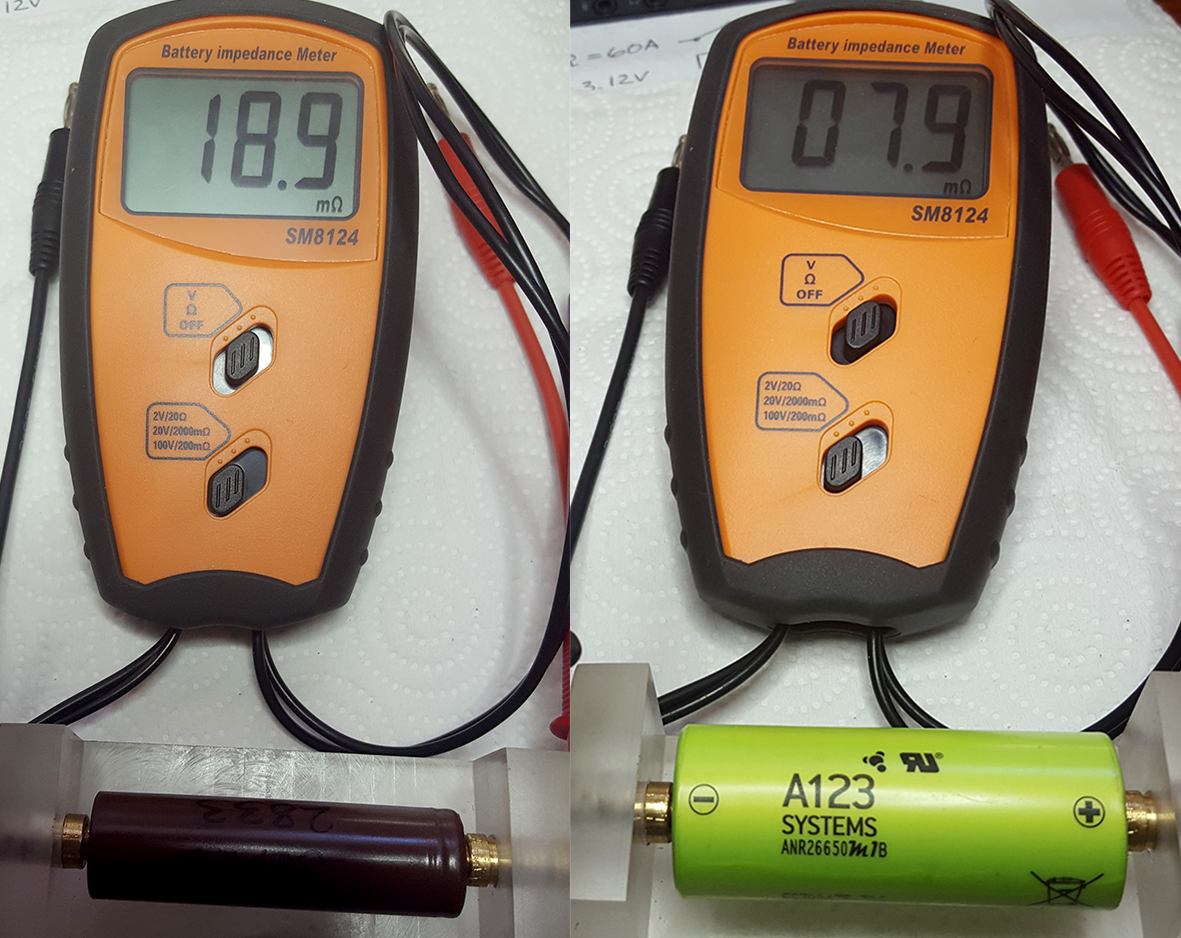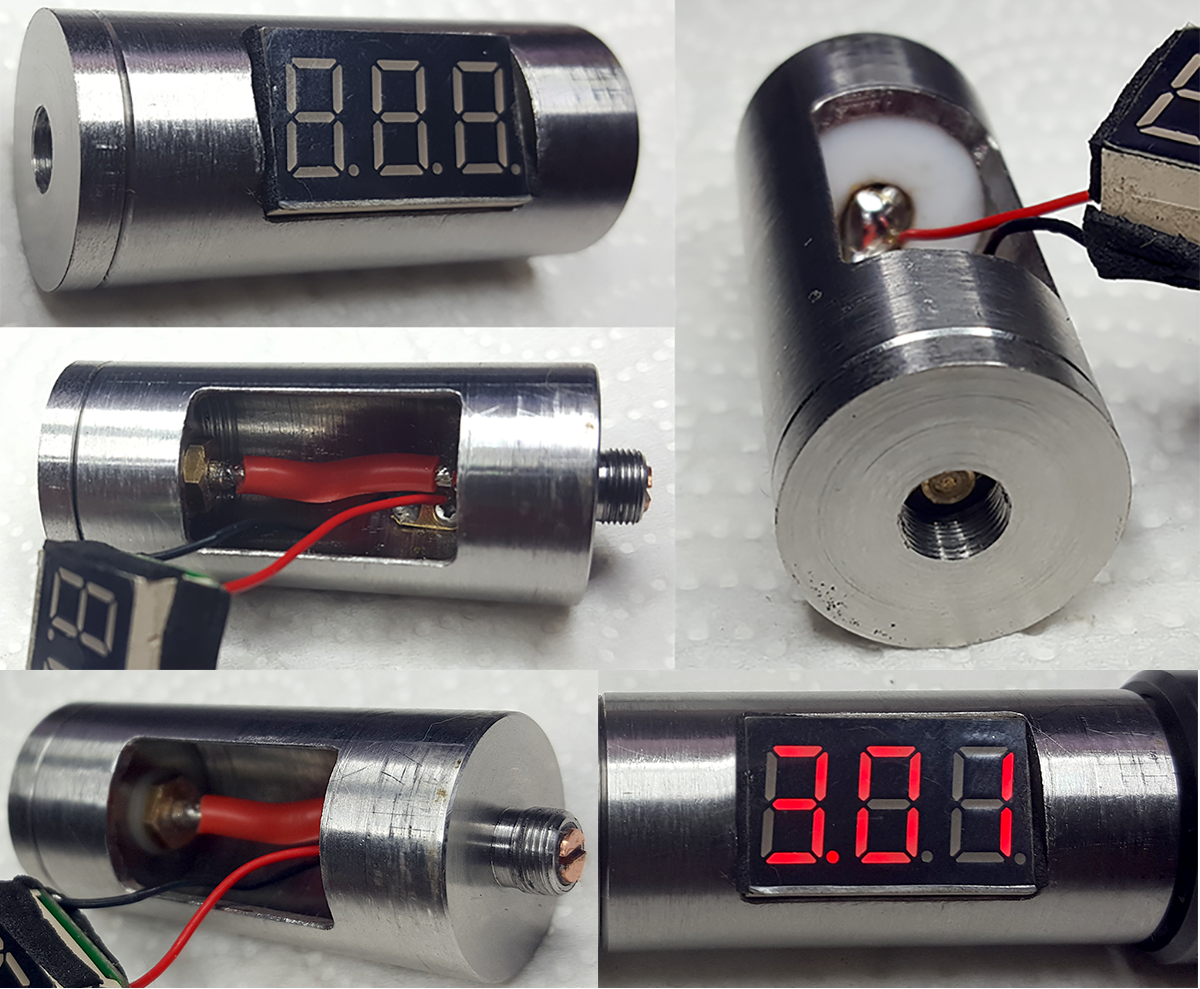These cells were donated for the purposes of testing by Nkon (www.nkon.nl) and EnerCig (www.enercig.com). Thank you! To prevent any confusion with the eGo-type "batteries", I use the term "cell" here to refer to a single 18350, 18650, 26650, etc.
While the test results are hard data, the conclusions and recommendations I make based on these tests are only my personal opinion based on my criteria for setting a rating. Carefully research any cell you are considering using before purchasing.
Testing cells at their limits is dangerous and should never, ever, be attempted by anyone who has not thoroughly studied the dangers involved and how to minimize them.
If the cell has only one current rating number on it, or if it says "max discharging current" then I have to assume that the company is stating that the cell can be discharged at that current level in any way, including continuously.





Bottom Line
This is an extraordinary cell that I am rating at 30A. The two cells I received from EnerCig and the two from Nkon appear to have come from the same batch.
The datasheet has a "maximum continuous discharge" rating of 70A in the datasheet. But at that temperature, about 85°C, the cell will have a significantly reduced cycle life. This rating is an absolute maximum, not a level you should operate the battery at for every cycle. To allow direct comparison against other batteries I am rating this cell at a level, 30A continuous, which limits the temperature to 60°C to ensure good cycle life. Above this temperature the cell's aging accelerates significantly. The cell can easily be pulsed at levels above 80A though.
This cell's lithium-ferrous-phosphate (LFP) chemistry is the safest of the Li-Ion chemistries we use. While this should never be used as an excuse to do so, these A123's can take a lot of abuse before going into thermal runaway. If they do go into runaway their reaction isn't as violent as the other chemistries.
The voltage of this cell is very steady for most of the discharge, very similar to LiPo's. This is great for unregulated/mechanical mod users. The iJoy 4200mAh 26650 is a better choice for vaping at up to about 40A though.
The 26650 ratings table has been updated to include this cell.
Things To Be Aware Of
- Their nominal voltage is 3.3V. This means they can't be used in regulated mods and their much lower voltage, when drawing a lot of current from them, probably limits their use to series unregulated/mechanical mods only.
- These batteries require a 3.6V charger! You cannot charge them to 4.2V.
- At high current levels the nominal voltage drops to as low as 2.5V.
- Unregulated or PWM mods using a MOSFET for button protection may not be able to use just one of these cells or use them just in parallel. The nominal voltage will be too low to turn many MOSFETs on fully at higher current levels. This can cause them to overheat and burn out.
-The "button" end of the cell is the NEGATIVE terminal, not the positive.
- The metal case of this cell is the POSITIVE terminal, not the negative like the other cylindrical cells we use.
- Due to the need to operate these in series, and their "reversed" polarity construction, I strongly recommend that only experienced vapers with in-depth knowledge of Ohm's Law, battery safety, and understanding of the ratings and requirements of this cell try using it. If you have questions that you cannot otherwise find the answers to, I urge you to not use this cell.
Continuous-Current Test Results

Pulse-Current Test Results


ANR26650M1-B Datasheet


Comments
List of Battery Tests | E-Cigarette Forum
https://www.e-cigarette-forum.com/f...afety-grades-and-pulse-performance-data.7566/
https://www.e-cigarette-forum.com/f...des-picking-a-safe-battery-to-vape-with.7447/
https://www.e-cigarette-forum.com/f...fety-grades-and-pulse-performance-data.7554//
While the test results are hard data, the conclusions and recommendations I make based on these tests are only my personal opinion based on my criteria for setting a rating. Carefully research any cell you are considering using before purchasing.
Testing cells at their limits is dangerous and should never, ever, be attempted by anyone who has not thoroughly studied the dangers involved and how to minimize them.
If the cell has only one current rating number on it, or if it says "max discharging current" then I have to assume that the company is stating that the cell can be discharged at that current level in any way, including continuously.


Bottom Line
This is an extraordinary cell that I am rating at 30A. The two cells I received from EnerCig and the two from Nkon appear to have come from the same batch.
The datasheet has a "maximum continuous discharge" rating of 70A in the datasheet. But at that temperature, about 85°C, the cell will have a significantly reduced cycle life. This rating is an absolute maximum, not a level you should operate the battery at for every cycle. To allow direct comparison against other batteries I am rating this cell at a level, 30A continuous, which limits the temperature to 60°C to ensure good cycle life. Above this temperature the cell's aging accelerates significantly. The cell can easily be pulsed at levels above 80A though.
This cell's lithium-ferrous-phosphate (LFP) chemistry is the safest of the Li-Ion chemistries we use. While this should never be used as an excuse to do so, these A123's can take a lot of abuse before going into thermal runaway. If they do go into runaway their reaction isn't as violent as the other chemistries.
The voltage of this cell is very steady for most of the discharge, very similar to LiPo's. This is great for unregulated/mechanical mod users. The iJoy 4200mAh 26650 is a better choice for vaping at up to about 40A though.
The 26650 ratings table has been updated to include this cell.
Things To Be Aware Of
- Their nominal voltage is 3.3V. This means they can't be used in regulated mods and their much lower voltage, when drawing a lot of current from them, probably limits their use to series unregulated/mechanical mods only.
- These batteries require a 3.6V charger! You cannot charge them to 4.2V.
- At high current levels the nominal voltage drops to as low as 2.5V.
- Unregulated or PWM mods using a MOSFET for button protection may not be able to use just one of these cells or use them just in parallel. The nominal voltage will be too low to turn many MOSFETs on fully at higher current levels. This can cause them to overheat and burn out.
-The "button" end of the cell is the NEGATIVE terminal, not the positive.
- The metal case of this cell is the POSITIVE terminal, not the negative like the other cylindrical cells we use.
- Due to the need to operate these in series, and their "reversed" polarity construction, I strongly recommend that only experienced vapers with in-depth knowledge of Ohm's Law, battery safety, and understanding of the ratings and requirements of this cell try using it. If you have questions that you cannot otherwise find the answers to, I urge you to not use this cell.
Continuous-Current Test Results
Pulse-Current Test Results
ANR26650M1-B Datasheet


Comments
- At 10A continuous it reached 2452mAh. This is great performance for a low internal resistance cell 2400mAh cell at 10A, and typical for its 2500mAh nominal rating, so I am rating it at 2400mAh.
- At 15A and 20A continuous the temperature rose to 46°C and 50°C, respectively. This is below the average temperature of a cell operating at its continuous discharge rating (CDR) and is an indication that we are operating below its true rating.
- At 30A continuous the temperature rose to 59°C. This is a just below the 60°C temperature at which its aging speeds up a lot and is an indication that we are operating at a level that helps to ensure a long cycle life.
- At 40A, 50A, and 60A continuous the temperature rose to 67°C, 75°C, and 80°C, respectively. The nominal voltage has dropped to about 2.55V at 60A.
- At 70A continuous the cell is running at below 2.5V, at near 85°C, but its discharge curve is still pretty flat.
- I am setting a CDR of 30A for this cell. While operating any cell near its rated maximum current level causes damage to the cell, I would expect good cycle life from this cell at 30A continuous.
List of Battery Tests | E-Cigarette Forum
https://www.e-cigarette-forum.com/f...afety-grades-and-pulse-performance-data.7566/
https://www.e-cigarette-forum.com/f...des-picking-a-safe-battery-to-vape-with.7447/
https://www.e-cigarette-forum.com/f...fety-grades-and-pulse-performance-data.7554//
Last edited by a moderator:












